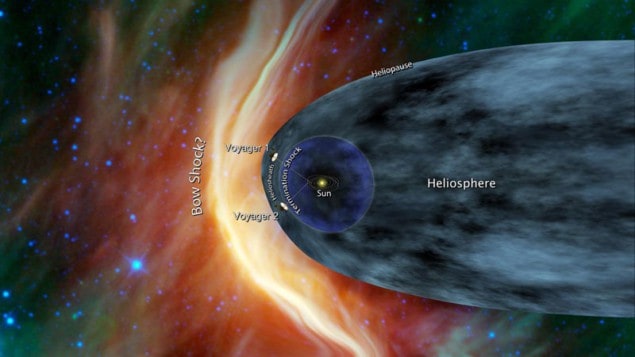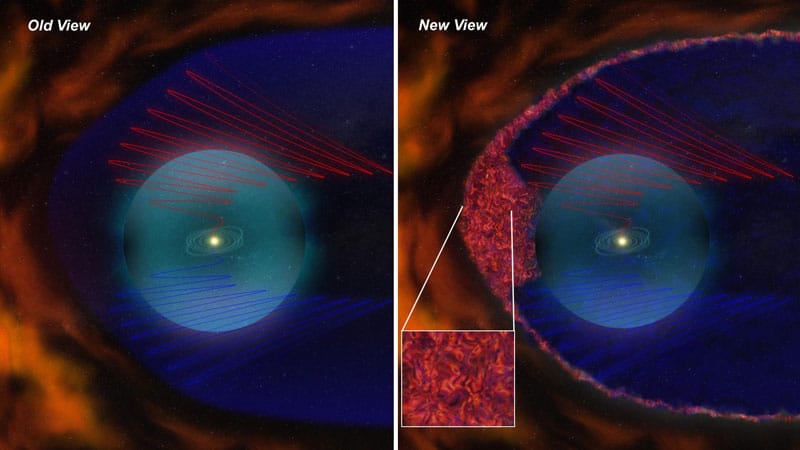
Unexpected observations by NASA’s Voyager 1 spacecraft have astronomers once again revising their theories about the radial extent of the heliosheath – the heated outer shell of the solar system. Recent data from the spacecraft have shown a gentle decrease in the velocity of the solar wind at the heliopause – the outer boundary of the heliosheath – not the abrupt discontinuity predicted by current theories. Also, scientists looking at other data from both Voyager 1 and Voyager 2 have found that the magnetic field in the heliosheath is a tumultuous foam of magnetic bubbles, as compared to the graceful arcs of magnetic field lines they had expected.
At the edge
Ionized particles emitted at high speeds from the Sun – the solar wind – form a bubble around our solar system. The skin of the bubble, called the heliosphere, contains the heliopause, the heliosheath and the termination shock. The solar wind travels at supersonic speed until it crosses a shockwave – the termination shock where it slows down and heats up the heliosheath. The heliopause is the outer edge of the heliosheath where the solar wind slows down to zero.
Launched nearly 34 years ago, and now cruising through space some 14.4 billion kilometres from the Sun, both Voyager 1 and Voyager 2 are currently in the heliosheath. A team of scientists led by Stamatios Krimigis of the Johns Hopkins University Applied Physics Laboratory, Maryland, US have been using Voyager’s Low-Energy Charged Particle instrument to determine the solar wind’s velocity. Voyager 1 has crossed into an area where the velocity of the solar wind has slowed gradually to zero since 2007. As Voyager 1 has moved outwards over the past three years, the radial velocity of the wind has been decreasing almost linearly from 208,000 km/h to zero; while the transverse component that flows sideways relative to the Sun is also trending toward zero.
“This tells us that Voyager 1 may be close to the heliopause, or the boundary at which the interstellar medium basically stops the outflow of solar wind,” says Krimigis. “The extended transition layer of near-zero outflow contradicts theories that predict a sharp transition to the interstellar flow at the heliopause – and means, once again, we will need to rework our models.”
As velocities may fluctuate, the team looked at multiple monthly readings before confirming the velocity was actually at zero. However, scientists believe Voyager 1 has not yet crossed the heliopause into interstellar space. Crossing into interstellar space would mean a sudden drop in the density of hot particles of the heliosheath and an increase in the density of cold particles of the interstellar plasma. The researchers, writing in Nature, estimated the location of the heliopause by combining the Voyager 1 observations and energetic neutral atom images of the heliosheath from the Cassini mission. They believe that the heliopause may be as close as 18 billion kilometres, meaning that Voyager 1 could exit the transition layer and enter the galactic medium by the end of 2012. The research was published in Nature Letters.
Bubble trouble
At the same time, another team from NASA has found distinct bubbles of magnetism, each about 160 million kilometres wide, in the heliosheath. Voyager 1 entered the “foam-zone” in around 2007 and Voyager 2 followed about a year later, according to the researchers, and it would take either one of the probes weeks to cross just one bubble.
“The Sun’s magnetic field extends all the way to the edge of the solar system,” explains Merav Opher of Boston University, US. “Because the Sun spins, its magnetic field becomes twisted and wrinkled, a bit like a ballerina’s skirt. Far, far away from the Sun, where the Voyagers are now, the folds of the skirt bunch up.”
When a magnetic field gets severely folded, lines of magnetic force criss-cross and reorganize themselves into foamy magnetic bubbles. This magnetic reconnection is the same energetic process underlying solar flares. The actual bubbles appear to be self-contained and disconnected from the broader solar magnetic field.
Sensor readings from the spacecraft show that the Voyagers sometimes travel in and out of bubbles in the foam – zone, while at other times they seem to move through foam-free regions. This further complicates our picture of the heliosphere.
The researchers suggest that the foam zone might protect the solar system from cosmic rays, which would be trapped inside the bubbles and have to travel through individual bubbles before arriving at relatively smoother magnetic field lines to travel towards the Sun itself. “The magnetic bubbles appear to be our first line of defence against cosmic rays,” points out Opher. “We haven’t figured out yet if this is a good thing or not.”
So far, most evidence for the bubbles comes from the Voyager energetic-particle and flow measurements and magnetic-field observations; but because the magnetic field is so weak, the data takes much longer to accurately analyse. “We’ll probably discover [if our model] is correct as the Voyagers proceed deeper into the froth and learn more about its organization,” says Opher. “This is just the beginning, and I predict more surprises ahead.”
Watch the video below from the NASA Heliophysics and the Science Visualization Studio to find out more about the bubbles and how cosmic rays may travel through them:




